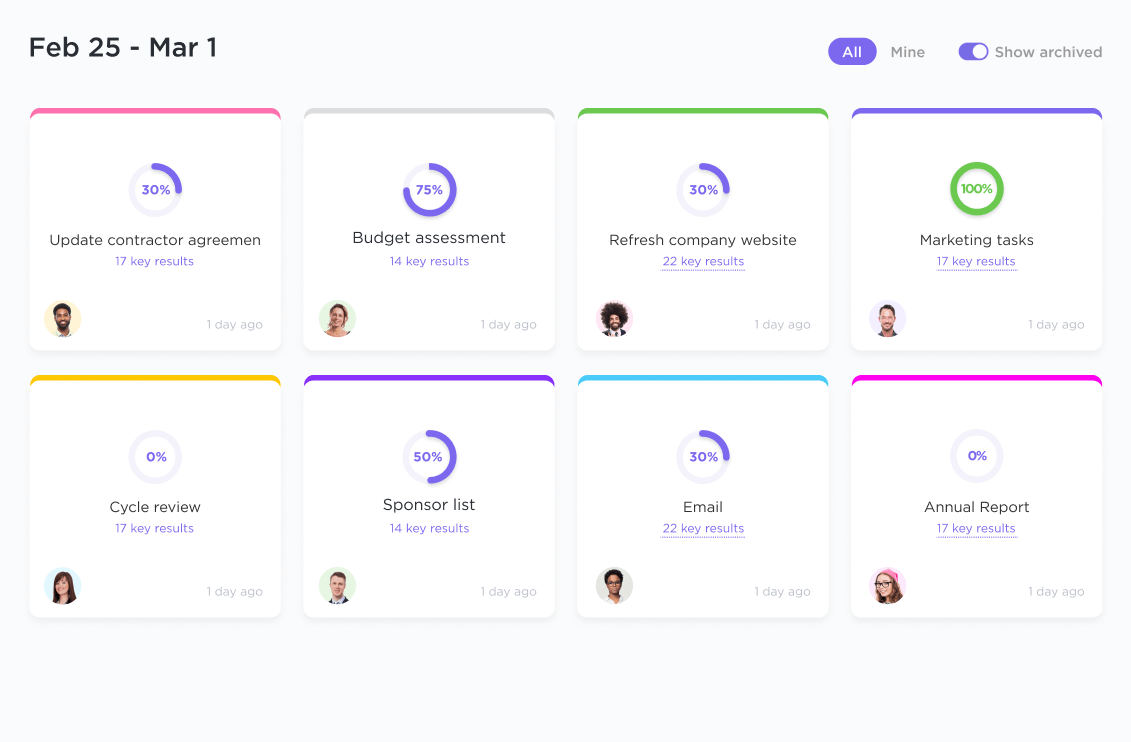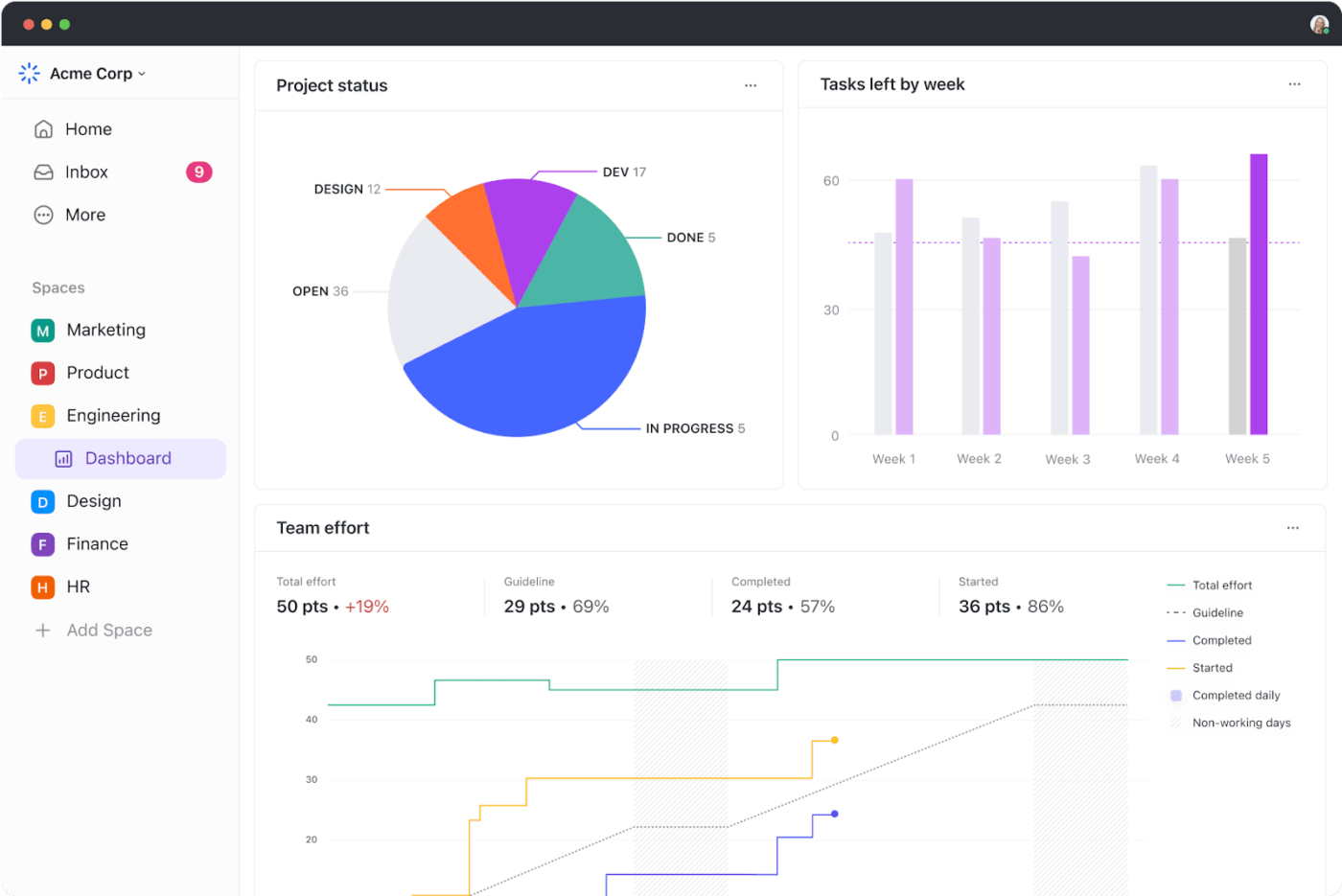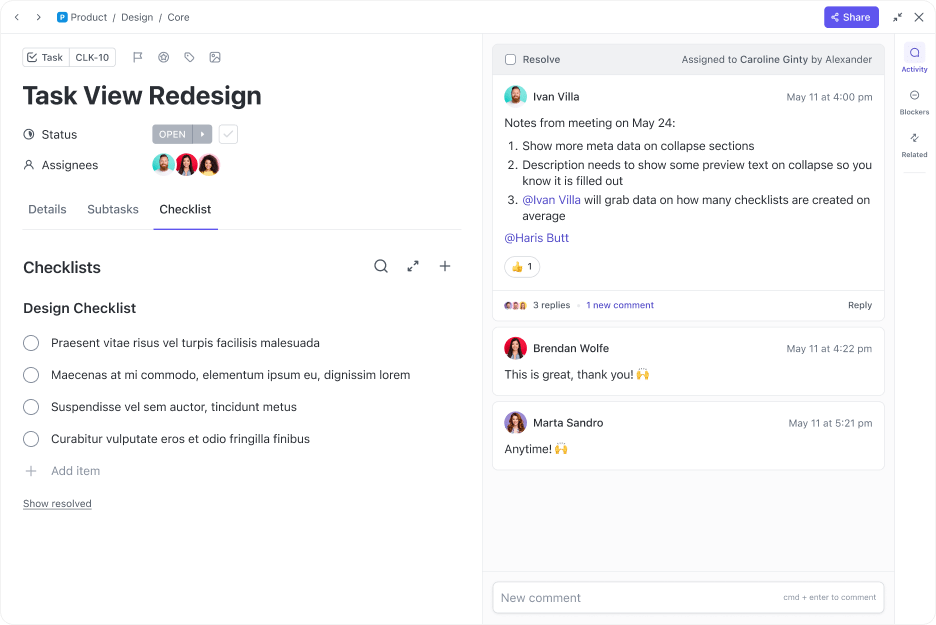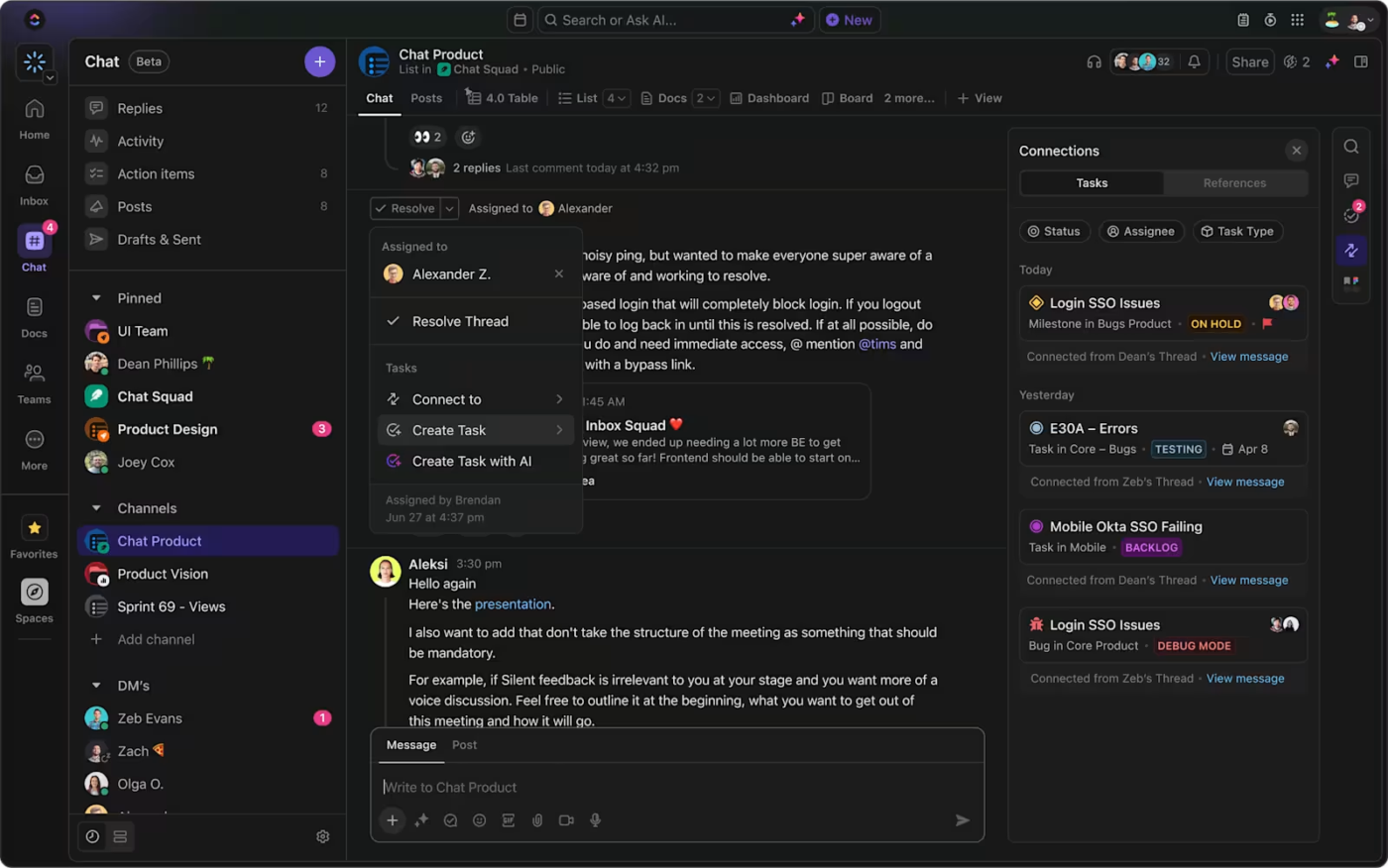Ever wonder how some people seem to go from answering support tickets to leading billion-dollar product lines? That’s the magic (and strategy) behind a well-planned product manager career path.
Take Maya, for example—she started her career in customer success, asked one too many questions about why features worked the way they did, and before long, she was managing her first product sprint. Today, she’s a senior product manager guiding an entire platform roadmap.
Whether you’re just curious about breaking into product management or you’re already a PM eyeing that next big promotion, understanding the full scope of your career path—from education to roles to salaries—is key.
In this guide, we’ll discuss every stage of the journey and how tools like Agile and ClickUp can accelerate progress. Let’s map out your growth, one product milestone at a time.
- Who Is a Product Manager?
- Product Manager Career Path & Growth Stages
- How to Start & Grow in a Product Management Career
- Step #1: Identify where you are in your PM journey
- Step #2: Learn the core principles of product management
- Step #3: Master the tools that product teams rely on
- Step #4: Build and ship real products or features
- Step #5: Develop soft skills and leadership qualities
- Step #6: Invest in community and mentorship
- Step #7: Regularly reflect and iterate on your progress
- Advancing Your Product Management Career with ClickUp
- Certifications & Courses to Advance Your Product Management Career
- Future Trends in Product Management
Who Is a Product Manager?
You know the person who connects the dots between customer needs, business goals, and engineering capabilities—that’s what a Product Manager (PM) does every day. They’re part strategist, part organizer, and part customer advocate.
If the product team were a band, the PM would be the conductor, making sure everyone plays in harmony and stays in sync with the big picture.
PMs are responsible for defining what to build, why it matters, and how success is measured. They collaborate with designers, engineers, marketers, and stakeholders to turn ideas into products people love to use.
Types of product managers
Not all product managers focus on the same things. Here are some common types of product managers you’ll come across:
- Technical Product Manager (TPM): Works on highly technical products like APIs, infrastructure, or data systems
- Growth Product Manager: Focuses on user acquisition, activation, retention, and revenue growth through data and experiments
- Platform Product Manager: Builds internal tools or systems that support other products or teams
- Consumer Product Manager: Designs products for end users with a strong focus on user experience and engagement
Each path requires a slightly different skill set, but they all play a key role in building and scaling great products.
Product Manager Career Path & Growth Stages
The product manager career path doesn’t follow a one-size-fits-all formula, but it typically grows in stages—from learning the ropes to leading entire product orgs.
Each step to becoming a product manager comes with new challenges, new titles, and yes, new salary ranges. Let’s break it down:
1. Entry-level roles
This is where most PMs get their start—learning how to write user stories, support launches, and understand user needs without being expected to call all the shots just yet.
⭐️ Common titles
- Associate Product Manager (APM)
- Junior Product Manager
- Product Analyst
💡 Responsibilities
- Support roadmap planning and documentation
- Conduct user and market research
- Write user stories and define acceptance criteria
- Help with QA testing and product launches
🎯 Skills needed
- Strong communication and curiosity
- Basic understanding of Agile and product development
- Analytical thinking and attention to detail
💰 Average salary
- $86,000 per year in the US
Example: Google and Uber have well-known APM programs that rotate you through different product management teams while learning on the job. You can also be a part of their technical product management roles if you are an engineer!
2. Mid-level product manager
At this stage, PMs start owning features or entire products. You’re expected to drive strategy, balance stakeholder needs, and ship meaningful updates.
⭐️ Common titles
- Product Manager
- Technical Product Manager
- Product Owner
💡 Responsibilities
- Define and drive product strategy
- Prioritize features and manage the backlog
- Collaborate with engineering, design, and marketing
- Analyze product metrics and iterate based on feedback
🎯 Skills needed
- Deep understanding of Agile or Scrum
- Strong decision-making and prioritization
- Technical knowledge (especially for Technical Product Manager roles)
- Stakeholder and team management
💰 Average salary
Example: A mid-level PM at a SaaS company might lead the launch of a new dashboard feature, working closely with devs and analyzing user adoption post-launch.
👀 Did You Know? 75% of product managers (working on both internal and external software products) say their companies lack established product management best practices or a formal product management function. These product management trends highlight the growing need for operational efficiency in the field.
3. Senior product manager roles
By this point, you’ve built and shipped enough products to know what works—and more importantly, what doesn’t. Now, you’re trusted to lead high-impact projects and mentor others along the way.
⭐️ Common titles
- Senior Product Manager
- Lead Product Manager
- Principal Product Manager
💡 Responsibilities
- Lead major product areas or features end-to-end
- Coach junior PMs and guide product execution
- Own the roadmap and feature delivery at scale
- Work closely with executives on strategic initiatives
🎯 Skills needed
- Strategic thinking and product vision
- Mentorship and team leadership
- Strong customer and business empathy
- Data-informed decision-making
💰 Average salary
Example: A Senior PM at a B2B SaaS company might manage the platform’s entire analytics suite, working with multiple dev teams and stakeholders.
4. Director of Product
Now you’re not just leading products—you’re leading people and product organizations. Your job is to scale teams, set vision, and align execution across departments.
⭐️ Common titles
- Director of Product
- VP of Product
- Group Product Manager (GPM)
💡 Responsibilities:
- Set department-level product goals and direction
- Manage multiple product teams or lines
- Collaborate with marketing, sales, and the C-suite to align business and product strategy
- Build and scale product team operations
🎯 Skills Needed
- Executive-level communication and negotiation
- Organization-wide influence and leadership
- Deep understanding of the market, customer, and competitive landscape
- Operational excellence and people management
💰 Average salary
Example: A Director of Product at a consumer tech company might oversee all mobile app experiences, from onboarding flows to new feature rollouts across global markets
5. Chief Product Officer (CPO)
It is the top of the product management career ladder, where your decisions shape the company’s direction and long-term success. You’re the voice of the product at the executive table.
⭐️ Common title
- Chief Product Officer (CPO)
💡 Responsibilities:
- Own the entire product vision and innovation roadmap
- Align product direction with overall business goals
- Influence company strategy and long-term planning
- Represent the product org to the board and investors
🎯 Skills needed
- Visionary thinking and market leadership
- Deep executive collaboration and influence
- PM experience scaling teams and leading large orgs
- Strong storytelling, positioning, and product evangelism
💰 Average salary
- $232,000 per year (often with equity or performance bonuses)
Example: A CPO at a unicorn startup might define the product strategy for global expansion, lead the product org, and report directly to the CEO.
Remember that each stage of the product management journey builds on the last. As your toolkit grows, your scope expands, and your impact also multiplies. Here’s what
Here’s what Shreyas Doshi, a PM leader who has worked across Stripe, Google, Twitter, and Yahoo, says about becoming a product manager.
How to Start & Grow in a Product Management Career
Whether you’re just breaking into the field in an associate product manager role or you’re already in a senior role aiming to level up, product management is a career built on continuous learning and iteration.
According to McKinsey, companies with strong product management functions outperform their peers by 20%, which means skilled PMs are in high demand.
Here’s how to build a lasting, fulfilling career in product, whether you’re starting out or stepping up.
Step #1: Identify where you are in your PM journey
🧭 Before you grow, you need to know where you’re starting from. Your strategy will look different depending on whether you’re:
- Exploring the product for the first time
- Transitioning from a related role (like engineering or marketing)
- Already a PM but aiming for a senior or leadership position
Example: A mid-career engineer with a knack for customer feedback can become a Technical Product Manager by taking ownership of internal tooling projects.
💜 Here’s how ClickUp helps
ClickUp is the everything app for work, that offers robust task management, seamless project tracking, and powerful collaboration tools to boost productivity and keep your team in sync. It also doubles up as a product management tool for agile teams, with a library of 1000+ templates.
For instance, the ClickUp Career Path Template will help you provide a clear roadmap to ensure you are on track for professional success.
With this template, you can:
- Understand what skills you need to develop to reach your career goals
- Have a clear understanding of the progression of your career
- Identify potential gaps in the skills and plan ahead for the future
- Make it easier to measure performance as a Product Manager
💡 Bonus: You can also try out the Job Search template to keep track of applications, job openings, company ratings, perks, your interview resources, and much more.
Step #2: Learn the core principles of product management
Foundational knowledge isn’t optional—every PM should understand 📚 :
- Agile and Scrum frameworks
- How to define user problems and write requirements
- Roadmapping, prioritization, and MVP thinking
- How to measure impact and success
Resources to level up as a PM:
- Inspired by Marty Cagan for strategic PM thinking
- Lean Product and Lean Analytics for data-driven decision-making
- Reforge or Product School for hands-on training
- Podcasts like Lenny’s Podcast and Product Thinking
Step #3: Master the tools that product teams rely on
Tools won’t make you a great PM—but they will make you faster, more effective, and easier to work with.
🛠 For daily execution and collaboration:
- ClickUp for sprint planning, task tracking, and real-time updates
- Figma/Miro for wireframes, whiteboarding, and UX feedback
🛠 For insights and optimization:
- Hotjar or FullStory for user behavior insights
- ClickUp Docs for documentation and knowledge sharing
Example: A Senior PM at a fast-scaling startup uses ClickUp to manage cross-functional launches—assigning tasks, aligning on goals, and integrating user feedback into weekly sprints.
💜 Here’s how ClickUp helps
ClickUp’s Product Management Solution provides various features for managing roadmaps, timelines, and sprints, ensuring teams stay aligned and productive.

It allows you to:
- Facilitate seamless collaboration within your team. Share updates, brainstorm ideas, and align stakeholders around shared goals, all within ClickUp
- Effortlessly generate documents, gather user feedback, and build a comprehensive product roadmap with AI-powered tools
- Organize work seamlessly across sprints, epics, and feedback. Facilitate workflows and automate tasks, minimizing manual effort and maximizing productivity
Step #4: Build and ship real products or features
Experience beats theory every time. Whether you’re junior or senior, consistently launching, learning, and iterating is key to growth.
🧪 Ideas for junior PMs:
- Contribute to internal tools or shadow launches
- Volunteer for cross-functional initiatives
- Start a passion project like a digital product or productivity app
🧪 Ideas for senior PMs:
- Lead discovery interviews and high-impact experiments
- Redesign key user flows based on behavioral data
- Build internal playbooks and product frameworks for your team
💜 Here’s how ClickUp helps
Use ClickUp Docs to build a comprehensive documentation around product development, such as outlining the product vision, strategy, and goals. Embed rich media, link related tasks, and tag team members to ensure everyone can access the latest information.

📖 Also Read: Best Skills Management Software (Reviews & Pricing)
Step #5: Develop soft skills and leadership qualities
Great PMs don’t just manage products—they influence without authority, build trust, and communicate clearly. As you grow, your soft skills become your superpower.
🌱 Key soft skills to focus on:
- Storytelling and presenting to stakeholders
- Prioritization and saying “no” with clarity
- Coaching, mentoring, and leading product teams
💜 Here’s how ClickUp helps
ClickUp Whiteboards are a product manager’s dream!
Try ClickUp’s Whiteboards for product teams to conduct brainstorming sessions into actionable tasks, embed those tasks in a Doc for context, chat with team members or leave comments on tasks for updates, and then track progress on a dashboard. And can do all this without leaving the ClickUp environment. Talk about efficiency!

Step #6: Invest in community and mentorship
No one grows in a vacuum. Connecting with others in the PM space can open doors to jobs, insights, and mentorship you didn’t even know you needed.
🤝 Ways to grow your network:
- Join Slack groups like Product-Led Alliance or Women in Product
- Attend virtual or in-person meetups (ProductTank, Mind the Product)
- Follow top PMs on LinkedIn and join the conversation
Example: A junior PM lands a career-defining mentorship by DM’ing a speaker after a ProductCon event.
Step #7: Regularly reflect and iterate on your progress
Your product career is your most important product—so treat it like one. Set professional goals, track wins, analyze what’s working, and pivot when needed.
Ways to track your growth:
- Use ClickUp’s Docs and Goals features to build your career roadmap
- Set quarterly OKRs for learning, project impact, or role growth
- Ask for feedback after every launch or major initiative
Whether you’re just getting started or aiming for a Director role, the key to product management growth is staying curious, shipping consistently, and learning from every iteration.
💜 Here’s how ClickUp helps
Use ClickUp Goals allows you to set objectives and key results (OKRs) to measure progress and ensure alignment with your strategic goals.

Here’s how it helps:
- Set clear, measurable targets: Define specific goals for each phase of the product lifecycle with measurable outcomes
- Track progress automatically: Monitor real-time progress and ensure you’re on track with built-in tracking features
- Break down larger goals: Divide big goals into smaller, actionable tasks for easy management
Additionally, ClickUp’s Dashboard allows you to create a visual representation of your projects, tasks, and overall productivity. It is a centralized place to monitor progress and performance across key metrics.

📖 Also Read: How to Use AI for Productivity (Use Cases & Tools)
Advancing Your Product Management Career with ClickUp
ClickUp offers a lot more. It is truly a product management software designed to streamline every facet of product management. I
It empowers rookie and senior product managers alike to centralize their work, encourage cross-department collaboration, and optimize processes throughout the entire product lifecycle.
💜 ClickUp Tasks
ClickUp Tasks, for example, allows you to create, assign, and track product tasks in real time. Set priorities, deadlines, and dependencies, ensuring everyone in your team is aligned on project goals.

💜 ClickUp MindMaps
Using ClickUp Mindmaps, you can document all your thoughts and discussions about ICPs in a shared working space. This is also where you can plan and frame all the action steps in developing your product.

💜 ClickUp Chat
ClickUp Chat, on the other hand, offers various functionalities that enable effective communication among team members. This is done without requiring the team members to switch between different applications, keeping discussions organized and contextually relevant.

You can link tasks and messages together, convert comments into actionable tasks, and ensure no critical information is missed.
Certifications & Courses to Advance Your Product Management Career
In product management, learning never stops. With the PM landscape evolving fast, especially with Agile, AI tools, and data-driven decision-making, investing in ongoing education isn’t just smart, it’s necessary.
Here are some high-impact, contemporary certifications and programs that can boost your product manager career path:
1. Product Management Certificate by Product School
📘 Course Name: Product Manager Certification (PMC)
📘 Who it’s for: Aspiring and mid-level PMs looking to build a solid foundation in product thinking, Agile, user research, and roadmapping
📘 Why it helps:
- Taught by real-world PMs from Google, Meta, and Netflix
- Offers hands-on projects and practical frameworks
- Highly recognized by tech companies and startups alike
2. Certified Scrum Product Owner (CSPO) by Scrum Alliance
🧠 Course name: Certified Scrum Product Owner (CSPO) course
🧠 Who it’s for: PMs who work on Agile teams and want to improve sprint planning, backlog grooming, and collaboration with devs
🧠 Why it helps:
- Gives you a solid grasp of Agile roles and rituals
- Helps you become a better facilitator and prioritizer
- Adds credibility with engineering teams
Friendly Reminder: Pair this with real Agile practice in ClickUp by using sprint boards, standup templates, and backlog views. Remember practice > theory!
3. Product Strategy Program by Reforge
🧪 Course name: Product Strategy Program
🧪 Who it’s for: Senior PMs, Group PMs, Directors, and Heads of Product who manage a portfolio of product work
🧪 Why it helps:
- Evaluate new and existing features based on feature adoption, retention, and satisfaction, and then map that to various improvement strategies
- Understand, evaluate, and prioritize PMF expansion opportunities
- Understand how to scale products with strategic investments in critical infrastructure
4. Growth Product Manager Nanodegree by Udacity
🛠️ Course name: Growth Product Manager, Nanodegree Program
🛠️ Who it’s for: Growth PMs, Senior PMs at scaling orgs
🛠️ Why it helps:
- Apply data science to create product proposals and design scalable data infrastructures
- Helps you speak fluently with engineers and bridge the tech-business gap
- Master UX design principles to enhance user experiences
Adding a few of these certifications to your resume won’t just signal expertise—it shows you’re invested in becoming a better, smarter, and more strategic product leader. That mindset will take you further than any job title.
📖 Bonus: Check out the Top AI courses for Product Managers to Stay Ahead
Use ClickUp to manage your learning goals
No matter which certification you choose, you’ll need a system to stay on track. ClickUp makes it easy to:
- Set quarterly learning OKRs with the Goals feature ✅
- Track courses and progress using Docs or checklists ✅
Here, you can try the ClickUp Personal Development Plan Template. It makes it easy to map your current skills against the requirements of in-demand skills. With this template, you can set specific goals for each skill you want to develop and track your progress over time.
It helps you identify gaps, whether in technical know-how, stakeholder management, or strategic thinking, so you can focus your efforts where they’ll have the most impact. The framework offers a structured way to plan actionable steps, such as taking courses, seeking mentorship, or working on cross-functional projects.
💡 Bonus: Institutions like Harvard, Stanford, ProductSchool, AIPMM, and PMI are well-known for their product management certification courses. Compare your options to find the one that best suits your needs.
📖 Also Read: Actionable Steps to Make a Career Change at Any Age
Future Trends in Product Management
The product management landscape is evolving faster than ever, driven by tech innovation, smarter tools, and changing customer expectations.
If you want to stay relevant and ahead of the curve, here are the top trends reshaping the product manager career path today and in the years to come:
🤖 AI-powered product development
Artificial Intelligence is no longer a nice-to-have—it’s becoming essential for workflow automation, enhancing user experiences, and driving innovation. According to McKinsey, 55% of product teams now integrate AI into at least one stage of product development.
💡 Pro Tip: ClickUp Brain helps PMs generate user stories, PRDs, and even brainstorm roadmap ideas instantly. It can also help you draft emails, summarize research documents, generate project ideas, and even write code. The AI adapts to your company’s specific language and style over time, making it feel like a custom-built tool.

📊 Data-driven decision-making
PMs are expected to make smarter, faster decisions, and that means turning data into insights that shape roadmaps and features. According to the Amplitude Product Report 2024, 87% of top-performing PMs use product analytics tools weekly.
🧠 User-centric innovation
Great products start with great user empathy. More teams are investing in discovery, interviews, and usability testing earlier in the dev cycle.
📮 ClickUp Insight: 15% of workers worry automation could threaten parts of their job, but 45% say it would free them to focus on higher-value work. The narrative is shifting—automation isn’t replacing roles, it’s reshaping them for greater impact.
For instance, in a product launch, ClickUp’s AI Agents can automate task assignments and deadline reminders and provide real-time status updates so teams can stop chasing updates and focus on strategy. That’s how project managers become project leaders!
💫 Real Results: Lulu Press saves 1 hour per day, per employee using ClickUp Automations—leading to a 12% increase in work efficiency.
🌍 Remote and async collaboration
Product teams are now global by default. Tools and systems that support asynchronous, distributed collaboration are shaping the new norm. Get ready to use ClickUp’s collaborative Docs, real-time chat, and goal tracking to keep teams aligned—no matter where they are in the world
In this day and age, staying future-ready means embracing these trends—and choosing tools like ClickUp that evolve with you.
Elevate Your Product Manager Career Path with ClickUp
Whether you’re just entering the product world or aiming for your next leadership role, one thing is clear—product management is a dynamic, high-impact career that rewards curiosity, strategy, and adaptability.
In this guide, we have explored what a product manager does, mapped out the career path for product managers, and walked through the roles, responsibilities, and salary expectations at every stage.
We have also covered how to grow your career through certifications, hands-on experience, and staying ahead of emerging trends like AI, data-driven decision-making, and user-first innovation.
But none of this happens in a vacuum—you need the right tools to make it all work.
ClickUp is the everything app for work that helps product managers stay organized, aligned, and agile. From sprint boards and roadmaps to real-time collaboration, user research, and goal tracking, ClickUp is built to power every stage of your product journey.
👉 Ready to level up your PM career? Sign up for ClickUp for free and start building products that make a difference.






